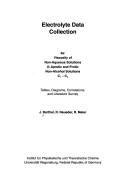| Listing 1 - 10 of 27 | << page >> |
Sort by
|

ISBN: 3926959339 Year: 1992 Publisher: Frankfurt am Main : Dechema,
Abstract | Keywords | Export | Availability | Bookmark
 Loading...
Loading...Choose an application
- Reference Manager
- EndNote
- RefWorks (Direct export to RefWorks)
ELECTRIC CONDUCTIVITY --- IONIC CONDUCTIVITY --- TRANSFERENCE NUMBER --- ELECTROLYTES --- PROPERTIES

ISBN: 3926959398 Year: 1993 Publisher: Frankfurt am Main : Dechema,
Abstract | Keywords | Export | Availability | Bookmark
 Loading...
Loading...Choose an application
- Reference Manager
- EndNote
- RefWorks (Direct export to RefWorks)
ELECTRIC CONDUCTIVITY --- IONIC CONDUCTIVITY --- TRANSFERENCE NUMBER --- ETHANOL --- PROPERTIES

ISBN: 392695941X Year: 1994 Publisher: Frankfurt am Main : Dechema,
Abstract | Keywords | Export | Availability | Bookmark
 Loading...
Loading...Choose an application
- Reference Manager
- EndNote
- RefWorks (Direct export to RefWorks)
ELECTRIC CONDUCTIVITY --- IONIC CONDUCTIVITY --- TRANSFERENCE NUMBER --- ALCOHOLS --- PROPERTIES

ISBN: 392695969X Year: 1996 Publisher: Frankfurt am Main : Dechema,
Abstract | Keywords | Export | Availability | Bookmark
 Loading...
Loading...Choose an application
- Reference Manager
- EndNote
- RefWorks (Direct export to RefWorks)
NITRILES --- ELECTRIC CONDUCTIVITY --- IONIC CONDUCTIVITY --- TRANSFERENCE NUMBER --- PROPERTIES

ISBN: 0521599490 0521400074 9780521599498 9780511524790 9780521400077 Year: 1997 Volume: 5 Publisher: Cambridge ; New York, NY : Cambridge University Press,
Abstract | Keywords | Export | Availability | Bookmark
 Loading...
Loading...Choose an application
- Reference Manager
- EndNote
- RefWorks (Direct export to RefWorks)
Electrochemistry --- Solid state chemistry --- Electrodes. --- Conducting polymers --- Interface --- Ionic conductivity --- Solid electrolytes
Book
Abstract | Keywords | Export | Availability | Bookmark
 Loading...
Loading...Choose an application
- Reference Manager
- EndNote
- RefWorks (Direct export to RefWorks)
Acid-base. --- Apparatus. --- Electrolytic dissociation. --- Gravimetry. --- Ionic conductivity. --- Visual titration. --- Volumetric analysis.

ISBN: 0824700112 9780824700119 Year: 1997 Publisher: New York, NY : Marcel Dekker,
Abstract | Keywords | Export | Availability | Bookmark
 Loading...
Loading...Choose an application
- Reference Manager
- EndNote
- RefWorks (Direct export to RefWorks)
fysicochemie --- Electrochemistry --- Ions. --- Ions --- Databases. --- Databases --- Electrolytes. --- Ions - Databases --- Electric potential --- Ionic conductivity --- Ionization potential and energy --- Magnetic susceptibility --- Thermodynamic properties
Book
Year: 2021 Publisher: Basel, Switzerland MDPI - Multidisciplinary Digital Publishing Institute
Abstract | Keywords | Export | Availability | Bookmark
 Loading...
Loading...Choose an application
- Reference Manager
- EndNote
- RefWorks (Direct export to RefWorks)
Lithium ion batteries (LIBs) are efficient storage systems for portable electronic devices, electrical power grids, and electrified transportation due to their high-energy density and low maintenance requirements. After their launch into the market in 1990s, they immediately became the dominant technology for portable systems. The development of LiBs for electric drive vehicles has been, in contrast, rather incremental. There are several critical issues, such as an energy density, system safety, cost, and environmental impact of the battery production processes, that remain challenges in the automotive field. In order to strengthen the LiB’s competitiveness and affordability in vehicle technology, the necessity of game-changer batteries is urgent. Recently, a novel approach going beyond Li batteries has become rapidly established. Several new chemistries have been proposed, leading to better performances in terms of energy density, long-life storage capability, safety, and sustainability. However, several challenges, such as a thorough understanding of mechanisms, cell design, long-term durability, and safety issues, have not yet been fully addressed. This book collects some recent developments and emerging trends in the field of “post-lithium” batteries, covering both fundamental and applied aspects of next-generation batteries
Research & information: general --- Technology: general issues --- metal-air --- zinc-air --- modeling --- simulation --- computational chemistry --- sodium-ion battery --- cathode --- solution combustion synthesis --- capacity retention --- Na0.44MnO2 --- garnet --- solid electrolyte --- lithium metal --- interface --- charge-transfer resistance --- polymer electrolyte --- single-ion conducting --- ionic conductivity --- Raman spectroscopy --- lithium glycerolate --- lithium single-ion conductor --- EIS --- Fourier-Transform Infrared Spectroscopy --- cycling --- catalyst --- carbon nanotubes --- Li-O2 battery
Book
Year: 2021 Publisher: Basel, Switzerland MDPI - Multidisciplinary Digital Publishing Institute
Abstract | Keywords | Export | Availability | Bookmark
 Loading...
Loading...Choose an application
- Reference Manager
- EndNote
- RefWorks (Direct export to RefWorks)
Lithium ion batteries (LIBs) are efficient storage systems for portable electronic devices, electrical power grids, and electrified transportation due to their high-energy density and low maintenance requirements. After their launch into the market in 1990s, they immediately became the dominant technology for portable systems. The development of LiBs for electric drive vehicles has been, in contrast, rather incremental. There are several critical issues, such as an energy density, system safety, cost, and environmental impact of the battery production processes, that remain challenges in the automotive field. In order to strengthen the LiB’s competitiveness and affordability in vehicle technology, the necessity of game-changer batteries is urgent. Recently, a novel approach going beyond Li batteries has become rapidly established. Several new chemistries have been proposed, leading to better performances in terms of energy density, long-life storage capability, safety, and sustainability. However, several challenges, such as a thorough understanding of mechanisms, cell design, long-term durability, and safety issues, have not yet been fully addressed. This book collects some recent developments and emerging trends in the field of “post-lithium” batteries, covering both fundamental and applied aspects of next-generation batteries
Research & information: general --- Technology: general issues --- metal-air --- zinc-air --- modeling --- simulation --- computational chemistry --- sodium-ion battery --- cathode --- solution combustion synthesis --- capacity retention --- Na0.44MnO2 --- garnet --- solid electrolyte --- lithium metal --- interface --- charge-transfer resistance --- polymer electrolyte --- single-ion conducting --- ionic conductivity --- Raman spectroscopy --- lithium glycerolate --- lithium single-ion conductor --- EIS --- Fourier-Transform Infrared Spectroscopy --- cycling --- catalyst --- carbon nanotubes --- Li-O2 battery
Book
Year: 2021 Publisher: Basel, Switzerland MDPI - Multidisciplinary Digital Publishing Institute
Abstract | Keywords | Export | Availability | Bookmark
 Loading...
Loading...Choose an application
- Reference Manager
- EndNote
- RefWorks (Direct export to RefWorks)
Lithium ion batteries (LIBs) are efficient storage systems for portable electronic devices, electrical power grids, and electrified transportation due to their high-energy density and low maintenance requirements. After their launch into the market in 1990s, they immediately became the dominant technology for portable systems. The development of LiBs for electric drive vehicles has been, in contrast, rather incremental. There are several critical issues, such as an energy density, system safety, cost, and environmental impact of the battery production processes, that remain challenges in the automotive field. In order to strengthen the LiB’s competitiveness and affordability in vehicle technology, the necessity of game-changer batteries is urgent. Recently, a novel approach going beyond Li batteries has become rapidly established. Several new chemistries have been proposed, leading to better performances in terms of energy density, long-life storage capability, safety, and sustainability. However, several challenges, such as a thorough understanding of mechanisms, cell design, long-term durability, and safety issues, have not yet been fully addressed. This book collects some recent developments and emerging trends in the field of “post-lithium” batteries, covering both fundamental and applied aspects of next-generation batteries
metal-air --- zinc-air --- modeling --- simulation --- computational chemistry --- sodium-ion battery --- cathode --- solution combustion synthesis --- capacity retention --- Na0.44MnO2 --- garnet --- solid electrolyte --- lithium metal --- interface --- charge-transfer resistance --- polymer electrolyte --- single-ion conducting --- ionic conductivity --- Raman spectroscopy --- lithium glycerolate --- lithium single-ion conductor --- EIS --- Fourier-Transform Infrared Spectroscopy --- cycling --- catalyst --- carbon nanotubes --- Li-O2 battery
| Listing 1 - 10 of 27 | << page >> |
Sort by
|

 Search
Search Feedback
Feedback About
About Help
Help News
News